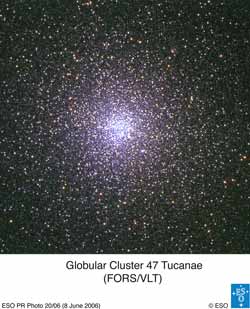The Toucan's Diamond

ESO PR Photo 20/06 is based on data obtained with FORS1 on Kueyen, UT2 of the Very Large Telescope. The image, 7 arcmin wide, covers the central core of the 30 arcmin large globular cluster. The observations were taken in three different filters: U, R, and a narrow-band filter centred around 485 nm, for a total exposure time of less than 5 minutes. The data were extracted from the ESO Science Archive and processed by Rubina Kotak (ESO) and the final image processing was done by Henri Boffin (ESO). North is up and East is to the left.
The Southern constellation Tucana (the Toucan) is probably best known as the home of the Small Magellanic Cloud, one of the satellite galaxies of the Milky Way. But Tucana also hosts another famous object that shines thousands of lights, like a magnificent, oversized diamond in the sky: the globular cluster 47 Tucanae. More popularly known as 47 Tuc, it is surpassed in size and brightness by only one other globular cluster, Omega Centauri.
Globular clusters are gigantic families of stars, comprising several tens of thousands of stars, all thought to be born at the same time from the same cloud of gas [1]. As such, they constitute unique laboratories for the study of how stars evolve and interact. This is even more so because they are located at the same distance, so the brightness of different types of stars, at different stages in their evolution can be directly compared.
The stars in globular clusters are held together by their mutual gravity which gives them their spherical shape, hence their name. Globular clusters are thought to be among the oldest objects in our Milky Way galaxy, and contain therefore mostly old, low-mass stars.
47 Tucanae is an impressive globular cluster that is visible with the unaided eye from the southern hemisphere. It was discovered in 1751 by the French astronomer Nicholas Louis de Lacaille who cataloged it in his list of southern nebulous objects. Located about 16 000 light years away, it has a total mass of about 1 million times the mass of the Sun and is 120 light years across, making it appear on the sky as big as the full moon.
The colour image of 47 Tucanae presented here was taken with FORS1 on ESO's Very Large Telescope in 2001. The image covers only the densest, very central part of the cluster. The globular cluster extends in reality four times further away! As can be seen however, the density of stars rapidly drops off when moving away from the centre. The red giants, stars that have used up all the hydrogen in their core and have increased in size, are especially easy to pick out.
47 Tuc is so dense that stars are less than a tenth of a light year apart, which is about the size of the Solar System. By comparison, the closest star to our Sun, Proxima Centauri, is four light years away. This high density causes many stars to 'bump' into each other, some getting 'married' in the process, or some stars in binary systems exchanging companions. These dynamic processes are the origin of many exotic objects, to be found in the cluster.
Thus, 47 Tuc contains a least twenty millisecond pulsars, i.e. neutron stars [2] rotating extremely rapidly around their axis, a few hundreds to one thousand times a second. Such peculiar objects are generally thought to have a companion from which they receive matter. (link to Chandra)
The Hubble Space Telescope recently also looked at 47 Tuc to study planets orbiting very close to their parent stars. This experiment showed that such 'hot Jupiters' must be much less common in 47 Tucanae than around stars in the Sun's neighbourhood. This may tell us either that the dense cluster environment is unhealthy for even such close planets, or that planet formation is a different matter today than it was very early in our Galaxy's history.
Media Contact
More Information:
http://www.eso.org/All latest news from the category: Physics and Astronomy
This area deals with the fundamental laws and building blocks of nature and how they interact, the properties and the behavior of matter, and research into space and time and their structures.
innovations-report provides in-depth reports and articles on subjects such as astrophysics, laser technologies, nuclear, quantum, particle and solid-state physics, nanotechnologies, planetary research and findings (Mars, Venus) and developments related to the Hubble Telescope.
Newest articles

NASA: Mystery of life’s handedness deepens
The mystery of why life uses molecules with specific orientations has deepened with a NASA-funded discovery that RNA — a key molecule thought to have potentially held the instructions for…

What are the effects of historic lithium mining on water quality?
Study reveals low levels of common contaminants but high levels of other elements in waters associated with an abandoned lithium mine. Lithium ore and mining waste from a historic lithium…

Quantum-inspired design boosts efficiency of heat-to-electricity conversion
Rice engineers take unconventional route to improving thermophotovoltaic systems. Researchers at Rice University have found a new way to improve a key element of thermophotovoltaic (TPV) systems, which convert heat…



